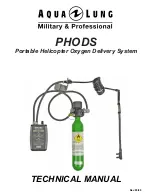
Bronkhorst®
Instruction Manual mini CORI-FLOW™ M1x
9.17.050O
14
2.6
Electrical connection
Electrical connections must be made with standard cables or according to the applicable hook-up diagrams. Make sure that
the power supply is suitable for the power ratings as indicated on the serial number label (see
), and that double
or reinforced insulation is used for the power supply cabling. For use in fieldbus systems, follow the instructions of the
cable supplier for the specific fieldbus system.
The equipment described in this document contains electronic components that are susceptible to
electrostatic
discharge
. In order to prevent damage, proper handling procedures must be followed during installation, (dis)connecting
and removing the electronics.
The equipment carries the CE-mark and is
compliant with the concerning EMC requirements
. However, EMC
requirements can only be met using appropriate cables and connector/gland assemblies. Bronkhorst recommends the use
of their standard cables. These cables have the right connectors and loose ends (if any) are marked to help prevent wrong
connection. When using other cables, cable wire diameters must be sufficient to carry the supply current, and voltage loss
must be kept as low as possible.
When connecting the product to other devices, be sure that the integrity of the shielding is not affected;
always use
shielded cabling for signals and communication and do not use unshielded wire terminals.
When in doubt about the suitability of your cabling, contact your Bronkhorst representative.
Never
power the instrument simultaneously from
two different power sources
(e.g. fieldbus and Plug-in Power Supply).
Doing so will irreversibly damage the printed circuit board and the instrument will have to be repaired before it can be
used.
Always isolate the electrical power before connecting or disconnecting equipment.
2.6.1
Analog or local connection
Connect the mini CORI-FLOW to the power supply/readout unit using a
cable with an 8-pin female connector on the instrument side. Refer to the
hook-up diagram for analog operation to connect the required signals.
For controllers, the control valve or pump is typically powered separately
via the actuator output.
2.6.2
Digital RS-232 connection
Using a special T-part RS-232 cable, the 8-pin DIN connector of the
instrument can be connected to a COM port or a USB port (via an RS-
232/USB converter) of a Windows computer. Power can be supplied by a
Plug-in Power Supply (PiPS) or via the optional fieldbus connection
(FLOW-BUS, Modbus, DeviceNet™).














































